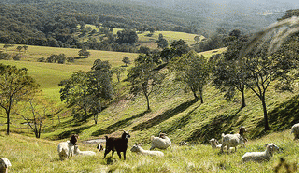Southern California is home to an enjoyable Mediterranean Climate resplendent with thousands of annual grasses and brush chaparral which germinate with the first fall rains growing throughout the cool winter. During the summer they grow quickly then die just as the perennial species begin their growth after surviving the dry summer in a dormant state.
By late June or July the biomass is so dense that small statured species can't get adequate moisture or sun so smothered, they begin to die off. If the rainfall is light or absent the standing vegetation then begins to dry out and decompose. Some decompose quickly while others remain intact as straw-like thatch. Within a year or two the ground is covered in a dense layer of dried plant material just waiting for a lightning strike, a match or a cigarette flung from a passing car to start a conflagration.
Southern California's mountainous terrain has roads winding through the hills with housing communities perched atop the flat mesas yielding those lovely views that Californian's covet.
Then there are the nature lovers who build million dollar homes at the end of a long winding road where they can live in the wilderness among the tall pine and oak trees. Maybe they have a few horses or chickens, a bee hive or two. It would be Heaven on earth if not for the constant threat of fire.
So the mandate has always been to keep the brush 50 to 100 yards from the homes, while the California Department of Forestry and Fire Protection (CAL FIRE) maintains a stewardship of over 31 million acres of California's privately-owned wildlands. The Department's firefighters, fire engines, and aircraft respond to an average of more than 5,600 wildland fires each year with an average of more than 172,000 acres of fires annually ---- that is, when there isn't a drought when the numbers can double.
Keeping dried thatch away is easier said than done. The terrain doesn't allow mowing which doesn't really work with the thatch anyhow. Manual labor, even cheap labor, is a never ending task. One millionaire surrounded his house with 200 yards of decorated concrete to foil the fire monster. That cost about half a million but he thought it was worth it. Then in the seventh year, the nasty fire creature swept up the hill blowing flaming embers over everything. The concrete survived but not the house.
They tried herbicides. That didn't work because it killed all the wildlife and gave people cancer.
Then CALFIRE tried backfires to get rid of the thatch and that worked for a while. But it has to be done each season and when our Santa Ana winds blow at 50 MPH, no fire stays under control.
My daughter who lives in the ritzy beach front town of Laguna Niguel has a homeowners association that spent $15,000 a month to water and care for the surrounding green growth. Then comes the drought and the state is rationing the water even if they want to pay for it. What to do?
Turns out there is a wonderful, environmentally correct solution. Turns out that goats just love that dry stuff. Four hundred fifty goats can clear out about an acre of tinder dry brush in a day. Food for the goats is the dry, dead brush that causes firefighters and homeowners their biggest concern. Bill Canaday and his company California Grazing out of Coalinga have been running about 1500 goats in Northern California for ages. His goats are loaded into double decker trailers to clear dead vegetation from along a waterway at Twin Dolphin Drive, then they head toward San Francisco to clear about six acres of brush underneath some towering PG & E power lines.
It's got to be goats and only goats say the experts at UC Davis. Sheep and cows not only don't like dried plants, they pull up the plants by the roots and disturb the plant ecology while the goats only eat the tops.
(Note: You can view every article as one long page if you sign up as an Advocate Member, or higher).





